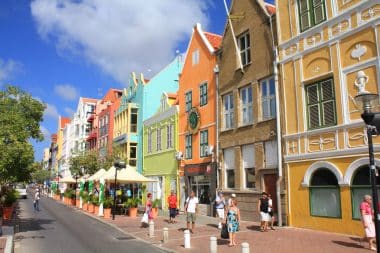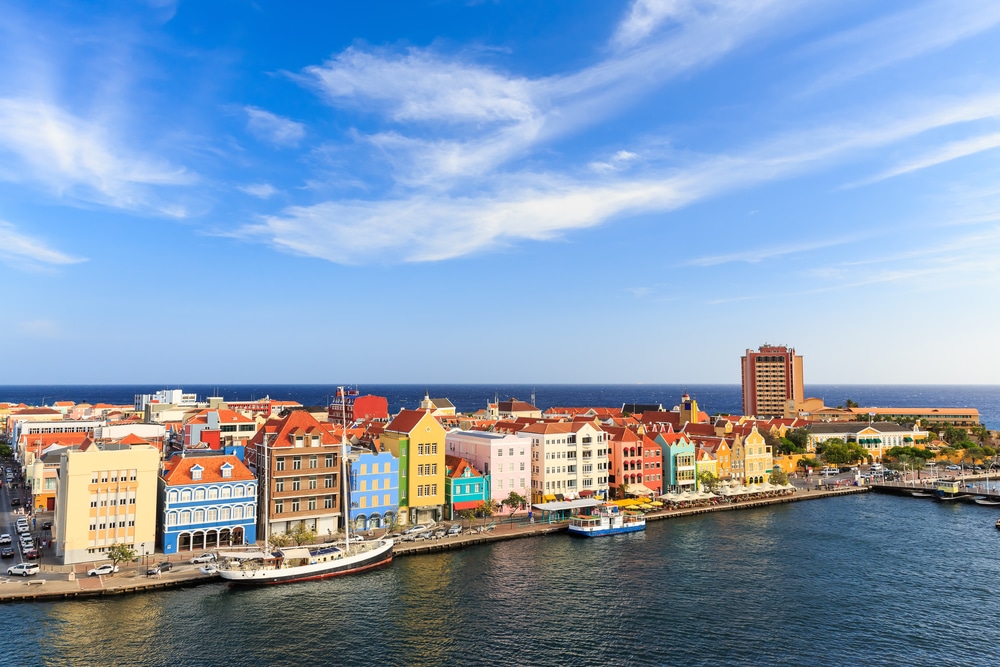The view of the colourful gabled houses of the historic “Handelskade” waterfront is breathtaking. Willemstad is the capital of the Caribbean island of Curaçao. If you’ve never been there, the city of 140,000 inhabitants is best imagined as a mini Amsterdam – only much more colourful. The town is located around the natural harbour Schottegat. Many of their old town houses are built in colonial style. This gives the place a touch of exoticism in addition to its eternal summer temperature.
White sandy coves in front of turquoise sea
The island of the southern Lesser Antilles – also known as the “Leeward Islands” – is located north of Venezuela. It was once a slave market and Dutch colony. That is long history. Curaçao is now an autonomous state of the Kingdom of the Netherlands and is “associated” with the EU. Its citizens have a Dutch passport. Willemstad is a paradise for tourists: As a free port, the city is ideal for inexpensive shopping, it has architectural and other cultural treasures and an extraordinary flora and fauna. It invites beach fans to the white bays for water sports and dives on the turquoise sea. Visitors can expect European standards. This applies to medical care or drinking water, which can be enjoyed from the tap without any problems.
UNESCO declares historic districts a World Heritage Site
Visitors communicate in Dutch, Spanish or English, although the native language of most residents is the Creole language “Papiamentu”. The majority of the locals are descendants of former slaves. Descendants of persecuted Jews maintain their religion and traditions to this day. They had to leave Europe in the 17th century and played a major role in the construction of Willemstad. In 1997, districts of Willemstad were declared a World Heritage Site by UNESCO, which triggered a restoration boom of the historic buildings from the colonial era. But modernization also has its downsides: by increasing rents and real estate prices, it leads to an expulsion of the poorer population from the somewhat run-down neighborhoods, which are gradually being polished to a high gloss.
For ships, the Queen Emma Bridge will be swung to the side

Cruise ships and tankers reach the port of Willemstad through St. Anne’s Bay. This is not a bay, but a strait with the function of a canal. Two famous bridges span over it – the pontoon crossing “Queen Emma Bridge” for pedestrians – swinging to the side and passable for ships – and the Queen Juliana Bridge, which takes cars over the water at a height of 490 meters. The bridges connect two historic neighborhoods on the Atlantic shore: Punda in the east and Otrabanda in the west.
On the Waaigat inlet, the floating market in Punda tempts you to buy fresh fruit, vegetables, fish and seafood. Also worth seeing is the old market hall “Plasa Bieu”, where you can eat well. Souvenir hunters will find interesting pieces of ceramics, carvings, straw braids or handmade kites in Punda. The nearby Mikvé Israel-Emanuel Synagogue from the 17th century is worth a visit, as is the simple Protestant Fortkerk in Fort Amsterdam, which was once built to defend the city and harbour.
The slave market used to be located in the Otrabanda district
Otrabanda is more rustic than Punda with its small alleys, but a little less chic. This used to be the district of the great slave market. In the dark, you should avoid its dark alleys, tour guides warn. Otherwise, Curaçao is considered safe. Beautiful colorful houses can also be seen in the Pietermaai district, which is also protected. Many galleries and studios can be found here. Where old houses have not yet been restored, artists are helping to beautify them provisionally with graffiti and murals. The Scharloo district is also all about creative people – now a real trendy district with co-working spaces, pretty apartments, trendy boutiques, cafés and restaurants. However, night owls will find most bars and restaurants in the Salina district. From the end of January to mid-February, Curaçao celebrates one of the largest carnivals in the Caribbean every year with street parties, music and large parades.
Delicious goat goulash from the many food stalls
In all parts of the city there are numerous food stalls or restaurants of all price ranges. The island’s cuisine features Spanish-Dutch, Southern, and Creole influences. Holidaymakers can’t get past rice, beans, plantains, cornmeal rolls, fish and seafood. Unless they insist on burgers with fries like at home. You should try specialties such as the cactus soup Kaduschi with meat or fish or Keshi Yena, cheese pockets filled with meat. The goat goulash Kabritu Stöba is delicious. Visitors can certainly easily do without the iguana soup, which is popular with locals.
A blue liqueur makes the island world famous
In the east of Willemstad, the Chobolobo country house on a former plantation is waiting for tourists to visit. Here you can learn everything about the liqueur that was created on Curaçao and has made the island world famous. However, the drink, which is made from the peel of bitter oranges and sugar, is unexpectedly colourful in typical island style: the liqueur is available in clear, green, blue and red. The blue color is said to have been created during production by a chemical reaction with a copper barrel. Today, food coloring is used all over the world.
Iguanas, turtles and a colorful bird life
Curaçao is also a destination for nature lovers, who get to see rare things on the island: iguanas can be observed in some bays. The bird world is colorful. Green parakeets with yellow heads, green-blue hummingbirds, the black and orange Baltimore rockets, the bright yellow sugar birds and the elegantly stalking flamingos in bright pink are striking. Visitors to Willemstad should not miss the “Seaquarium” and the “Zoo & Botanical Garden” to see dolphins and turtles as well.


